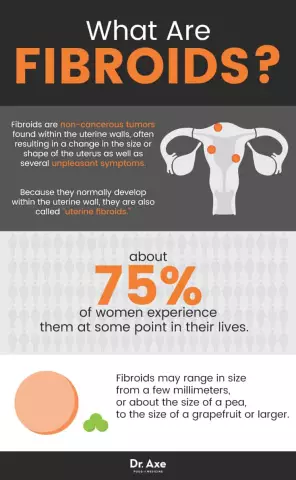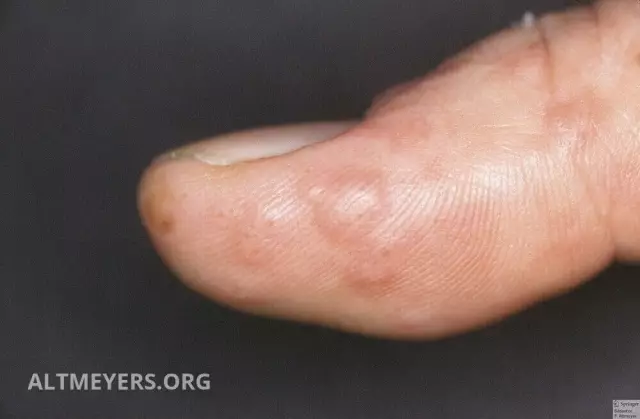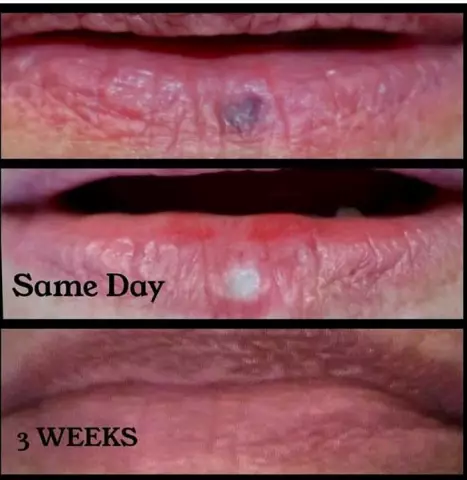- Author Rachel Wainwright [email protected].
- Public 2023-12-15 07:39.
- Last modified 2025-11-02 20:14.
Shingles
Brief description of the disease

Shingles belongs to the group of acute infectious diseases. Shingles affects peripheral nerves in some areas of the skin, which leads to intoxication of the body, inflammation of the dorsal roots of the spinal cord and the appearance of a blistering rash. As a rule, adults and children over the age of 10 suffer from this infection, and shingles develops only in those individuals who have had chickenpox. Racial, gender, and seasonal factors do not have any influence on the onset and progression of the disease.
Shingles causes
The causative agent of shingles, the chickenpox virus, affects the intervertebral nerve nodes and the dorsal roots of the spinal cord. The risk group includes people who:
- are exposed to influences that weaken the immune system (chemotherapy, radiation treatment, immunotherapy, HIV infection);
- are often overworked or experiencing constant psychological stress;
- suffer from cancer;
- are in old age and pay little attention to their health.
All these factors can cause shingles, the symptoms of which are manifested as a result of the activation of the latent form of the varicella-zoster virus. For many years, herpes zoster may have had no clinical symptoms, but a coincidence of adverse factors made him wake up.
Signs of shingles
There are four groups of herpes zoster symptoms: pain, sensory disturbances, general intoxication, and skin manifestations.
Most often, sensitivity disorders with shingles are observed in the area of rashes and healed ulcers, but they can also appear on healthy areas of the skin. Signs of general intoxication include:
- weakness;
- decreased appetite;
- nausea, vomiting;
- temperature rise;
- weight loss.
Painful sensations occur a few days before the appearance of a blistering rash. They are worse at night or under the influence of any external stimuli (cold, warmth, touch). When diagnosed with shingles, pains are localized along the nerves and can vary from mild to intolerable. In some cases, patients with herpes zoster note the presence of severe headache, which increases with a change in head position.
Skin manifestations in shingles are also localized along the nerves. They look like small red spots of various shapes or small bubbles surrounded by a dark red rim. These bubbles are filled with transparent contents and pass after a few weeks, leaving behind only a dried crust. If a person is found to have advanced shingles, the treatment of skin manifestations can last longer than usual, since the inflammatory process often affects the deep layers of the skin, penetrates the dermis. In such cases, the blisters also heal completely, but leave deep scars. As for the localization of the rash, in most patients it appears all over the body, just like with chickenpox.
Possible complications of shingles
With a severe clinical course and inadequate treatment, herpes zoster can lead to serious complications. The most common ones are:
- paralysis, manifested as a result of damage to the motor branches of the nerves;
- inflammation of the lungs, duodenum, bladder;
- eye lesions of varying severity;
- paralysis of the facial nerve and distortion of the face to one side.
Due to the risk of complications, doctors urge patients to abandon self-medication and seek help from specialized institutions in time. If patients use exclusively folk remedies, shingles will never go away completely and will significantly worsen a person's quality of life.
Shingles treatment

The main activities are aimed at destroying the herpes virus and reducing the intensity of pain. As a rule, healthcare workers use antiviral drugs (methisazone, acyclovir, valacyclovir, famciclovir). To relieve pain, ganglion blockers (pyrilene, gangleron) are used. Note that severe pain can persist even after the rash disappears and the course of treatment is completed, therefore, when discharging from the hospital, analgesics (aspirin, analgin, paracetamol, indomethacin) are recommended. If severe, advanced herpes zoster is diagnosed, treatment includes anticonvulsants and gamma-aminobutyric acid.
Alternative treatment for shingles
Once again, I would like to note that the alternative treatment of shingles is an addition to the main medical procedures and nothing else. Otherwise, the patient runs the risk of getting many serious complications, including paralysis and facial distortion.
To relieve pain and itching with shingles, the following folk remedies are traditionally used:
- swimming in sulphurous or salt water;
- lubrication of damaged skin areas with bitter almond oil;
- compresses of bread mixed with salt, which are applied to the body 1-2 times a day for 20-30 minutes;
- folk remedies from burdock leaves or fresh juice of this plant help well with shingles. Please note only that before making a compress, the leaves must be poured with boiling water and infused for 12 hours. Instead of burdock, you can use fresh toadflax grass, boiled with milk and mixed with butter in a 1: 1 ratio.
YouTube video related to the article:
The information is generalized and provided for informational purposes only. At the first sign of illness, see your doctor. Self-medication is hazardous to health!






